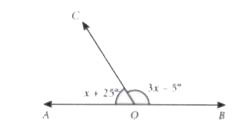In a pair of adjacent angles, (i) vertex is always common, (ii) one arm is always common, and (iii) uncommon arms are always opposite rays
Then
All (i), (ii) and (iii) are true
(iii) is false
(i) is false but (ii) and (iii) are true
(ii) is false
Step by step video & image solution for In a pair of adjacent angles, (i) vertex is always common, (ii) one arm is always common, and (iii) uncommon arms are always opposite rays Then by Maths experts to help you in doubts & scoring excellent marks in Class 7 exams.
Updated on:21/07/2023Topper's Solved these Questions
- LINES AND ANGLES BOOK - NCERT EXEMPLARCHAPTER - LINES AND ANGLES EXERCISE - Exercise (fill in the blanks)
3 Videos
- LINES AND ANGLES BOOK - NCERT EXEMPLARCHAPTER - LINES AND ANGLES EXERCISE - Think and Discuss
6 Videos
- INTEGERSBOOK - NCERT EXEMPLARCHAPTER - INTEGERSEXERCISE - VOCOBULARY
5 Videos
- PERIMETER AND AREABOOK - NCERT EXEMPLARCHAPTER - PERIMETER AND AREAEXERCISE - Think and Discuss
7 Videos
Similar Questions
Knowledge Check
Which of the following options is correct :-
A pair of adjacent angles have.
(i)Common vertex
(ii)Common Arm.
(iii)Non Common arms are an opposite sides of common arms.
(iv)Non Common arms are on the same side of common arms.A(i) & (ii) are sufficientB(i),(ii) & (iii) are sufficientC(i) ,(ii) & (iv) are sufficientDAll are sufficientConsider the following statements: when two straight lines intersect:
(i) adjacent angles are complementary
(ii) adjacent angles are supplementary
(iii) opposite angles are equal
(iv) opposite angles are supplementaryA(i) and (iv) are correctB(i) and (iii) are correctC(ii) and (iii) are correctD(ii) and (iii) are correctWhen a body is acclerated : (i) its velocity always changes (ii) its speed always changes (iii) its direction always changes (iv) its speed may or may not change.
Which of the following is correct ?A(i) and (ii)B(i) and (iv)C(i) onlyD(ii) and (iii)
Consider the following statements: When two straight lines intersect:
(i)adjacent angles are complementary
(ii)adjacent angles are supplementary
(iii)opposite angles are equal
(iv)opposite angles are supplementary
Of those statements
(a) (i) and (iii) are correct
(b) (ii) and (iii) are correct
(c) (i) and (iv) are correct
(d) (ii) and (iv) are correct
View SolutionAssertion : The value of x in the following figure is 40°.

Reason: A linear pair is a pair of adjacent angles whose non-common arms are opposite rays.
View SolutionIf the sum of the two adjacent angles is 180∘; then their non-common arms are two oppposite rays.
View SolutionCommon difference of an A.P. is always positive.
View SolutionDuring decomposition of an activated comples.
(i).energy is always releasing
(ii).energy is always absorbed
(iii).energy does not change
(iv).reactants may be formed
View Solution
